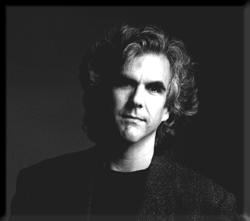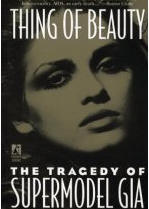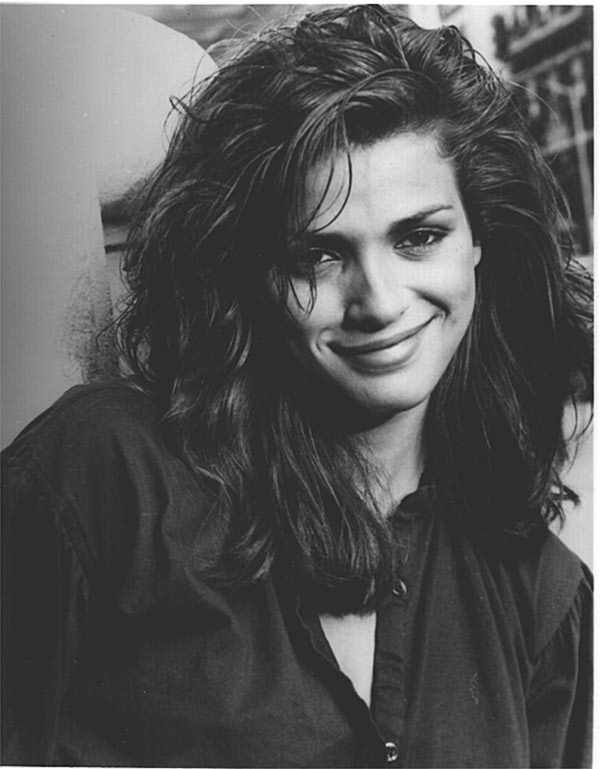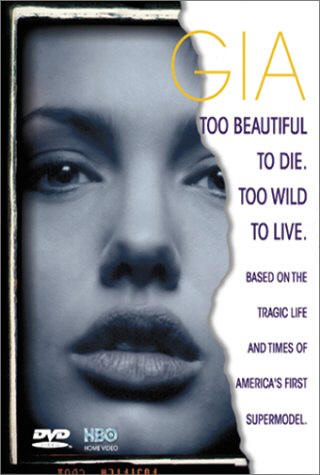

PopEntertainment.com > Feature Interviews
- Authors > Feature Interviews F to J >
Stephen Fried
 Stephen Fried
Stephen Fried
Gia and
the High Cost of Beauty
by
Ronald Sklar
Copyright ©2006 PopEntertainment.com. All rights reserved.
Posted:
September 18, 2006.
Twenty years ago, the fashion world's first
supermodel, Gia Carangi, died of complications from AIDS. It was a shock
that made the world reel, at a time when the human race was just barely
coming to grips with the reality of the illness (seemingly invincible
actor Rock Hudson died a year later). What was even more frightening: Gia
was one of the first women in America to die of the disease.
By the mid-eighties, Gia's spectacular and
as-yet-unparalleled modeling career was long over. She began to
self-destruct early on, mostly from drugs and partly from a misguided
search for love (she was an avowed lesbian). However, when she first made
the scene in 1978, she was something to behold, a "thing of beauty," as
the title of Stephen Fried's classic biography ironically suggests (Thing
of Beauty: The Tragedy of Supermodel Gia, Pocket Books, 1993).
In the shallow, cut-throat business of fashion
modeling, Gia was at first a golden child. She was beloved and cared for
(while she was on top, that is). Very few of the fashionistas (as
Fried famously termed those in and around the fashion business) kept up
with Gia as she began and eventually completed her tragic fall. The
business moved on quickly – succeeding supermodel Cindy Crawford was first
known as Baby Gia.
The publication of Fried's book in the 1990s – and a
subsequent HBO film on her life starring Angelina Jolie – helped fuel the
growing interest in this stunning and sad woman.
To this day, Gia's rags-to-riches-to-rags story
continues to fascinate, from her humble, working-class beginnings in
Northeast Philadelphia to her scaling of the heights on the runways and in
the photography studios of New York, Milan and Paris.
On the twentieth anniversary year of Gia's death,
investigative journalist Stephen Fried reflects on the life and legacy of
this beautiful, heartbreaking subject – we learn what he has learned, and
we are reminded of what her story really means.
 Gia was
more than just a pretty face. She was a very complex person with as much
ambiguity as charm and intelligence. Are you able to describe her to us?
Gia was
more than just a pretty face. She was a very complex person with as much
ambiguity as charm and intelligence. Are you able to describe her to us?
I did my best to describe her in the book, seen
through the eyes of the people who knew her. I never met her myself (even
though she lived near me for a time in Philadelphia) and I know from
talking to others that she was different things to different people—not
uncommon for a model, or a woman who didn't live past her mid-20s. I think
those who care about her—and that group grows as people find the book and
the HBO film—will continue to try to describe her. I can still only
provide the raw material which they will process their own way.
Has your
take on Gia changed since you wrote the book over a decade ago?
Not much. I was fascinated by Gia because she
was a product of the broken homes and broken promises of the 60s and
70s—the fact that she was a model, and people might be more interested in
the story of her family, her homosexuality and her battle with
self-destructiveness was just an added bonus. The only thing I probably
see a little differently grows out of the changes in the field of
psychiatry. When I started telling Gia's story, in a magazine article in
the 80s, the importance of biological psychiatry was still being explained
to Americans. The issues about whether Gia's problems were from nature or
nurture got caught up in the debate between psychodynamics and
biological-based mental illness. While Gia had plenty of family
problems—her parents' divorce, her very close but very challenging
relationship with her mom—I suspect both I and her doctors didn't pay
enough attention to her underlying mental illness. If HIV hadn't taken
her, I suspect she would have responded very well to the newer psychiatric
medications and types of therapy. At least, I like to think that.
How did the
idea to write the book come about? How difficult was it to uncover the
truth about her life?
I knew about Gia because she was from
Philadelphia and had been on the cover of
Philadelphia
magazine when I was just out of college—several years before I worked
there. Very few people knew she was dead, and about year after her death
her mother called into a TV talk show about AIDS and told the host, Wally
Kennedy, that Gia was her daughter and she had died of AIDS—as a way of
encouraging Wally to cover the disease more. Wally and I had done some
previous programs together, and he called me and suggested I meet Gia's
mom, that there might be a good story. He was right. I did a long magazine
piece on Gia's life and death and felt when it was done that there was
much more of a story than I had been able to tell even in a 15,000-word
magazine article. So, I did a book proposal and was fortunate to get a
deal to expand the research and the writing into Thing of Beauty.
 How was
your experience gathering information and stories from
fashionistas?
How was
your experience gathering information and stories from
fashionistas?
Well, everybody who agreed to speak to me was
great. It took a long time to convince some people—just because they were
nervous about talking about AIDS and wanted to make sure that what I was
doing would be true to Gia's life and her memory—but once they agreed to
see me, they were very forthcoming, very emotional and very moving. Many
of these are people who the public considers to be somehow "shallow"
because they work in fashion. I'd say in all my years of interviewing, I
never spoke to people as deeply as I did about Gia. A lot of the people
who did talk did so because Monique Pillard at Elite, or Francesco
Scavullo, the photographer, told them I was OK. They had been sources for
the original article, and opened a lot of doors. They both loved Gia very
much, and both felt they could have done more to save her; they may have
been too hard on themselves in that regard, but I think that what they
allowed me to do was something that serves as a powerful cautionary tale
for a lot of people. They were brave to trust me. My only regret is the
people who would not talk to me, but who later read the book and wished
they had: especially Gia's close friend Sandy Linter, who was my holy
grail during the research, never did speak to me for the book, but was
very kind and insightful when I met her later on.
Before your
book, Gia was only known among insiders in the modeling and fashion
businesses. That, of course, soon changed. How is Gia perceived by
"civilians" who are not involved in the glamour industries? Do they find
it to be a Cinderella story, a cautionary tale, or both?
I don't think Gia could ever be confused with
Cinderella; she was way too tough for that. I wanted to tell Gia's story
so it would be a cautionary tale, to a lot of different kinds of
people—the least of which were people in fashion. It's a cautionary tale
about family dysfunction, about substance abuse, about homosexuality,
about AIDS, about superficiality, about pain perceived as sexiness. The
book was not meant to be about glamour, and my pleasant surprise is that
most readers see beneath the surface of the fashion business where it is
set.
Your book
caused a sensation when it was first published in the 1990s. What was that
experience like for you? Did you expect the response that the book
received?
I'm not sure it caused a sensation—it got some
attention and some good reviews, and that was certainly pretty great,
especially since it was my first book. It got excerpted in Vanity Fair
which led to me working there for a number of years—so I met my editor
there, Wayne Lawson, through it, and that was significant, he's an amazing
editor. The movie stuff surrounding it was intriguing. Eric Bogosian was
hired to write the screenplay. We spent some time together, which was
great, and remain friendly; the same is true for Robin Swicord, the
screenwriter hired to replace him. And the entertainment lawyer I hired
when HBO ripped off the book, Steve Rohde, remains a friend. The initial
response, actually, isn't really what I remember that much. The more
interesting experience has been that 13 years later, people are still
reading and talking about the book, and Gia is a cultural touchstone, at
least in some cultures. And luckily I'm still writing books—I'm on my
fourth—as is my wife, novelist Diane Ayres, who edited the book.
 How did the
people in Gia's life – particularly those who agreed to talk with you --
react to your story?
How did the
people in Gia's life – particularly those who agreed to talk with you --
react to your story?
They all seemed relieved that I had told such
an emotionally difficult story truthfully and without oversensationalizing
it. Only Gia's mom seemed upset, but that was predictable—any mother
reading a book about her dead daughter would be upset, especially if it
deviated from her own view of the story. But, I'll give Kathy credit, she
helped me with the original article and the book, even when she knew that
other people would be telling me harsh things about her. I think she felt
the book was biased against her—that when she told me a story and somebody
else told me another version, that I should have picked hers, or favored
hers. Then when the HBO film came out and portrayed her, so unfairly, as
such a one-dimensional monster, she had a little better appreciation that
I really had attempted to show all sides of a situation that, ultimately,
only Gia could tell us what really happened. I've remained friends, or at
least friendly, with almost everyone who helped with that book. I think
they all feel like they went through a powerful experience with Gia when
she was alive, and another one as they helped me recreate aspects of her
life.
To what do
you owe Gia's fall? Was it her destructive personality, her chaotic family
life or the fast-lane lifestyle of the modeling business?
Gia died of AIDS, and only of AIDS. You can't
forget that. If she hadn't contracted HIV, I'd like to think that all the
things that contributed to her "fall" would later have informed her second
life as a really interesting, powerful grown-up. The disease stole that
chance from her. But, just to be clear, the modeling business didn't kill
Gia and ultimately neither did her family—they just fed her mental
illness, and the cycles of self-destructiveness and self-medication. We
now know what both the modeling business and her family could have done to
help her, but we cannot know if she would have been able to stick with the
treatment necessary to control her illness.
Had Gia
somehow managed to live, where would she be today?
She thought she would be an actress or a
photographer, with a career likely interrupted by kids, which she very
much wanted. She also wanted to be able to be a lesbian and be married,
and I think she'd be delighted to see that is more possible today than it
was in 1986.
 What did
you think of Angelina Jolie playing the title role in the HBO film based
on your book? How about Faye Dunaway as Wilhelmina Cooper?
What did
you think of Angelina Jolie playing the title role in the HBO film based
on your book? How about Faye Dunaway as Wilhelmina Cooper?
Just so you're clear: while the HBO film was
clearly based on my book, my book was at the time under option to
Paramount
and is still part of a film in turnaround at
Paramount.
So I had nothing to do with the HBO film except to threaten legal action
when I saw it. That said, I very much wanted
Paramount
to hire Angelina Jolie, who my wife and I had seen in Foxfire, to
play Gia; I think she did very well with the screenplay she had to work
with. Everybody else in the film was OK—it's not Mercedes Reuhl's fault
that the Kathy character was written that way—but nobody in it made me
shiver with recognition of a character I'd spent a lot of time with except
Angelina's portrayal of Gia.
The term
fashionista
has been adopted by the fashion industry and the press. Do you get a
royalty check every time the term is used?
I wish. Although, honestly, it's more than
enough that I invented a word that is now in the Oxford English
Dictionary. It's especially gratifying because my wife, the English major,
always gives me a lot of grief for making up words in my journalism—the
fact that I'm now mentioned in an entry in the OED, one of her bibles, is
very amusing to me. Less so to her. I'm amazed and fascinated that the
word caught on, especially since it has come to mean something fairly
different than the meaning I created it to have. I used it in the book
because there was no other word that described the army of beautifying
people who work in fashion shoots—the models, hair and makeup people, etc.
And it wasn't meant to be pejorative, just descriptive of a group of
people who work much harder than people realize. But, once something gets
out into the culture—a word, a book—you can't control it.
What
project(s) are you currently working on? What can we expect from you in
the near future?
I'm working on my fourth book, but it's the
first biography since Thing of Beauty; a much different kind of
book—a historical biography set in the U.S. in the late 1800s and early
1900s—but in many ways similar because it combines an unforgettable family
who made a real impact on the country, and reporting that attempts to
explore less appreciated aspects of American cultural history. The book is
about legendary hospitality entrepreneur Fred Harvey and the civilizing of
the American West by his restaurants and his Harvey Girls, the country's
first corps of working women. It's due out in a year or so from Bantam.
I've also been doing a monthly column for Ladies Home Journal which
attempts to explain the mind of the modern husband to the magazine's
thirteen million readers; it has been great fun,
and there are now enough of those pieces that there could be a collection.